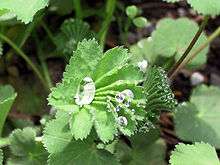Alchemilla mollis
| Alchemilla mollis | |
|---|---|
| Alchemilla mollis as ground cover | |
| Scientific classification | |
| Kingdom: | Plantae |
| (unranked): | Angiosperms |
| (unranked): | Eudicots |
| (unranked): | Rosids |
| Order: | Rosales |
| Family: | Rosaceae |
| Genus: | Alchemilla |
| Species: | A. mollis |
| Binomial name | |
| Alchemilla mollis (Buser) Rothm. | |
Alchemilla mollis, the garden lady's-mantle[1] or lady's-mantle,[2] is an herbaceous perennial plant native to southern Europe and grown throughout the world as an ornamental garden plant. It grows 30 to 45 cm (12 to 18 in) tall, with leaves that are palmately veined, with a scalloped and serrated margin. The stipules are noteworthy in that they are fused together and leaf like. The chartreuse yellow flowers are held in dense clusters above the foliage. This plant,[3] together with a similar but dwarf variety, A. erythropoda,[4] has gained the Royal Horticultural Society's Award of Garden Merit. The plant self-seeds freely and can become invasive.
According to some accounts, lady's mantle has been used for centuries as an herbal remedy. According to other authorities, however, it has never been used medicinally, but has been confused with two species that have a history of medicinal use: A. alpina (alpine lady's mantle) and A. xanthoclora.[5]

The plant is often grown as a ground cover, and is valued for the appearance of its leaves in wet weather. Water beads on the leaves due to their dewetting properties. These beads of water were considered by alchemists to be the purest form of water. They used this water in their quest to turn base metal into gold, hence the name Alchemilla.
Notes
- ↑ "BSBI List 2007". Botanical Society of Britain and Ireland. Archived from the original (xls) on 2015-01-25. Retrieved 2014-10-17.
- ↑ "Alchemilla mollis". Natural Resources Conservation Service PLANTS Database. USDA. Retrieved 7 January 2016.
- ↑ "Alchemilla mollis AGM". RHS Plant Finder. Royal Horticultural Society. Retrieved 27 July 2013.
- ↑ "Alchemilla erythropoda AGM". RHS Plant Finder. Royal Horticultural Society. Retrieved 27 July 2013.
- ↑ Gardner, Jo Ann; Holly S. Dougherty (2005). Herbs in Bloom: A Guide to Growing Herbs as Ornamental Plants. Timber Press. p. 79. ISBN 978-0-88192-698-9.